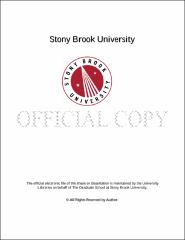| dc.identifier.uri | http://hdl.handle.net/11401/76777 | |
| dc.description.sponsorship | This work is sponsored by the Stony Brook University Graduate School in compliance with the requirements for completion of degree. | en_US |
| dc.format | Monograph | |
| dc.format.medium | Electronic Resource | en_US |
| dc.language.iso | en_US | |
| dc.publisher | The Graduate School, Stony Brook University: Stony Brook, NY. | |
| dc.type | Dissertation | |
| dcterms.abstract | Contemporary research has suggested that in order for students to compete globally in the 21st century workplace, pedagogy must shift to include the integration of science and mathematics, where teachers effectively incorporate the two disciplines seamlessly. Mathematics facilitates a deeper understanding of science concepts and has been linked to improved student perception of the integration of science and mathematics. Although there is adequate literature to substantiate students’ positive responses to integration in terms of attitudes, there has been little empirical data to support significant academic improvement when both disciplines are taught in an integrated method. This research study, conducted at several school districts on Long Island and New York City, New York, examined teachers’ attitudes toward integration and students’ attitudes about, and achievement on assessments in, an integrated 8th grade science classroom compared to students in a non-integrated classroom. An examination of these parameters was conducted to analyze the impact of the sizeable investment of time and resources needed to teach an integrated curriculum effectively. These resources included substantial teacher training, planning time, collaboration with colleagues, and administration of student assessments. The findings suggest that students had positive outcomes associated with experiencing an integrated science and mathematics curriculum, though these were only weakly correlated with teacher confidence in implementing the integrated model successfully. The positive outcomes included the ability of students to understand scientific concepts within a concrete mathematical framework, improved confidence in applying mathematics to scientific ideas, and increased agreement with the usefulness of mathematics in interpreting science concepts. Implications of these research findings may be of benefit to educators and policymakers looking to adapt integrated curricula in order to improve the preparation of students to learn and achieve in a global society. | |
| dcterms.abstract | Contemporary research has suggested that in order for students to compete globally in the 21st century workplace, pedagogy must shift to include the integration of science and mathematics, where teachers effectively incorporate the two disciplines seamlessly. Mathematics facilitates a deeper understanding of science concepts and has been linked to improved student perception of the integration of science and mathematics. Although there is adequate literature to substantiate students’ positive responses to integration in terms of attitudes, there has been little empirical data to support significant academic improvement when both disciplines are taught in an integrated method. This research study, conducted at several school districts on Long Island and New York City, New York, examined teachers’ attitudes toward integration and students’ attitudes about, and achievement on assessments in, an integrated 8th grade science classroom compared to students in a non-integrated classroom. An examination of these parameters was conducted to analyze the impact of the sizeable investment of time and resources needed to teach an integrated curriculum effectively. These resources included substantial teacher training, planning time, collaboration with colleagues, and administration of student assessments. The findings suggest that students had positive outcomes associated with experiencing an integrated science and mathematics curriculum, though these were only weakly correlated with teacher confidence in implementing the integrated model successfully. The positive outcomes included the ability of students to understand scientific concepts within a concrete mathematical framework, improved confidence in applying mathematics to scientific ideas, and increased agreement with the usefulness of mathematics in interpreting science concepts. Implications of these research findings may be of benefit to educators and policymakers looking to adapt integrated curricula in order to improve the preparation of students to learn and achieve in a global society. | |
| dcterms.available | 2017-09-20T16:51:10Z | |
| dcterms.contributor | Kelly, Angela M | en_US |
| dcterms.contributor | Sheppard, Keith | en_US |
| dcterms.contributor | Berger, Lisa | en_US |
| dcterms.contributor | Anderson, O. R.. | en_US |
| dcterms.creator | McHugh, Luisa | |
| dcterms.dateAccepted | 2017-09-20T16:51:10Z | |
| dcterms.dateSubmitted | 2017-09-20T16:51:10Z | |
| dcterms.description | Department of Science Education | en_US |
| dcterms.extent | 146 pg. | en_US |
| dcterms.format | Monograph | |
| dcterms.format | Application/PDF | en_US |
| dcterms.identifier | http://hdl.handle.net/11401/76777 | |
| dcterms.issued | 2016-12-01 | |
| dcterms.language | en_US | |
| dcterms.provenance | Made available in DSpace on 2017-09-20T16:51:10Z (GMT). No. of bitstreams: 1
McHugh_grad.sunysb_0771E_12732.pdf: 1955629 bytes, checksum: a480ad6f2ff54fc750fb1742e73f44b3 (MD5)
Previous issue date: 1 | en |
| dcterms.publisher | The Graduate School, Stony Brook University: Stony Brook, NY. | |
| dcterms.subject | Science education | |
| dcterms.subject | Integration, Math, Science | |
| dcterms.title | The Integration of Mathematics in Middle School Science: Student and Teacher Impacts Related to Science Achievement and Attitudes Towards Integration | |
| dcterms.type | Dissertation | |

